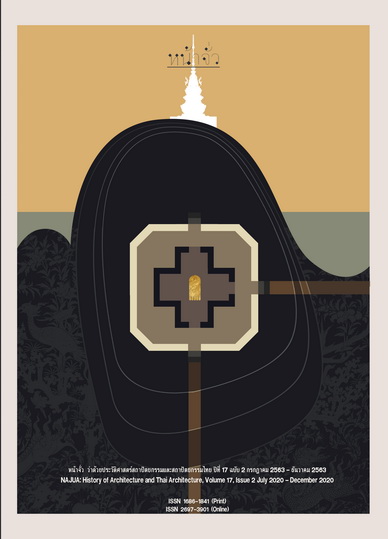Green Building Design and Major Renovation Guidelines for Government Offices
Main Article Content
Abstract
The Department of Public Works and Town & Country Planning (DPT) has determined to increase the role of the government sector to mitigate climate change problems and environmental systems, where buildings contribute partially to these problems. DPT, therefore, aims to establish green government office design guidelines for new construction as well as major renovation. The study method was done via reviewing green building rating systems in Thailand and other countries, establishing a green building rating tool, testing the tool with selected buildings and calculating the cost increase in addition to value for money. Two buildings were selected as case studies, one was a new building with classical Thai style, and the other an existing office, where both were considered extra large buildings according to the building construction code.
To observe design issues that needed correction in order to pass the green building criteria, a post-occupancy survey was conducted in the existing office. It was found that the Thai classical style building was able to pass the prerequisites as well as any other contemporary style building. However, its high-sloped roof hinders some criteria from being achieved such as the installation of solar ready roofs, the collection of rainwater from roofs, and the reduction of urban heat island effect from the roof.
Modification of the ventilation system was required by both the new and existing building in order to meet the minimum ventilation rate criteria. The Thai classical style building especially needs to have an appropriately placed intake and exhaust air grills on the exterior wall or roof for both mechanical and aesthetic concerns.
The new building design is made of 72 criteria, 32 prerequisites and 40 option credits, with contents concerning site selection, project administration, master planning, building design, construction, operation and maintenance. On the other hand, the major renovation includes 26 criteria and 42 credits. All prerequisites must be met in order for the building to be considered as a DPT green government office building, if the building can also achieve more than half of the total option credits, it will be considered as a DPT high-level green office building.
The cost increase to establish a new green building was about 2 % and 4% to adapt an existing building. For the high-level green building, the increase was about 8% for the new building, and 7% for major renovation. However, it is worth mentioning that the standard green building has better value for money than the high-level green building. DPT has made all design criteria for both new construction and major renovation available as e-books through their website.
Downloads
Article Details
References
ASHRAE. ANSI/ASHRAE/USGBC/IES Standard 189.1: Standard for the Design of High-Performance Green Buildings Except Low-Rise Residential Buildings. Atlanta, GA: ASHRAE, 2017.
Building and Construction Authority (BCA). BCA Green Mark for Existing Non-Residential Buildings for Piloting (GMENRB: 2017). n.p.: BCA, 2017. Accessed May 2, 2019. Available from https://www.bca.gov.sg/GreenMark/others/GM_ENRB_2017_simplified_criteria.pdf
Building and Construction Authority (BCA). Green Mark for Non-Residential Buildings NRB 2015 (GM NRM: 2015) n.p.: BCA, 2015. Accessed May 10, 2019. Available from https://www.bca.gov.sg/GreenMark/others/Green_Mark_NRB_2015_Criteria.pdf
Building and Construction Authority (BCA). Realizing Singapore’s Green Building Dream-Towards a Future Ready Built Environment. Singapore: BCA., n.d.
Bureau of Environmental Health, Department of Health. khūmư̄ kān patibat ngān phư̄a kān trūat pramoēn khunnaphāp ʻākāt phāinai ʻākhān samrap čhaonāthī [Indoor Air Quality Assessment Method for Assessor]. Nonthaburi: Bureau of Environmental Health, 2016.
Department of Alternative Energy Development and Efficiency. rāingān sarup nǣothāng kānʻō̜kbǣp prayat phalangngān ʻākhān tonbǣp prayat phalangngān khrōngkān sưksā læ phatthanā phư̄a sāng tonbǣp ʻākhān ʻanurak phalangngān samrap phāk rat [Summary Report-Guidelines for Energy Efficient Building Design-Prototypes for Government Buildings]. n.p.: Department of Alternative Energy Development and Efficiency, 2015.
Department of Alternative Energy Development and Efficiency. Document for Seminar: Revision of Energy Efficiency Standard and Comments Regarding Software for Evaluating Building Envelope. The Twin Tower Hotel, Bangkok, October 18, 2016.
Department of Public Works and Town & Country Planning. khūmư̄ kānʻō̜kbǣp ʻākhān phāk rat thī čha kō̜sāng mai hai pen ʻākhān khīeo phāk rat [Green Government Office Design Guidelines for New Construction-version 1.0]. Bangkok: Department of Public Works and Town & Country Planning, 2019. Accessed May 10, 2019. Available from http://subsites.dpt.go.th/edocument/images/pdf/sd_work/62/G-GOODsNC.pdf
Department of Public Works and Town & Country Planning. khūmư̄ kānʻō̜kbǣp prapprung ʻākhān phāk rat thī mī yū doēm hai pen ʻākhān khīeo phāk rat [Green Government Office Design Guidelines for Renovation-version 1.0]. Bangkok: Department of Public Works and Town & Country Planning, 2019. Accessed May 10, 2019. Available from http://subsites.dpt.go.th/edocument/images/pdf/sd_work/62/G-GOODsNC.pdf
International WELL Building Institute. The WELL Building Standard v1 with January 2017 Addenda. New York: Delos Living LCC, 2017.
Pollution Control Department. khūmư̄ kēn kānpramoēn ʻākhān khīeo phāk rat (kō̜ranī ʻākhān doēm) [Green Building Rating System for Government Offices (For Existing Building)]. Accessed August 28, 2020. Available from http://infofile.pcd.go.th/ptech/gb_obd_2556.pdf
Pollution Control Department. khūmư̄ kēn kānpramoēn ʻākhān khīeo phāk rat (kō̜ranī thī čha mī kānkō̜sāng ʻākhān mai) [Green Building Rating System for Government Offices (For New Construction)]. Accessed August 28, 2020. Available from http://infofile.pcd.go.th/ptech/GB_NBD_2556.pdf
Thai Green Building Institute. khūmư̄ samrap kēn kānpramoēn khwāmyangyư̄n thāng phalangngān læ singwǣtlō̜m Thai samrap ʻākhān rawāng chai ngān [Thai’s Rating of Energy and Environmental Sustainability for Existing Building-version 1.0]. n.p.: Thai Green Building Institute, n.d.
Thai Green Building Institute. khūmư̄ samrap kēn kānpramoēn khwāmyangyư̄n thāng phalangngān læ singwǣtlō̜m Thai samrap kānkō̜sāng læ prapprung khrōngkān mai læ ʻākhān praphēt phư̄nthī sūan klāng læ krō̜p ʻākhān [Thai’s Rating of Energy and Environmental Sustainability for New Construction and Major Renovation and Core and Shell Building- version 1.1]. n.p.: Thai Green Building Institute, n.d.
U.S. Green Building Council. LEED Reference Guide for Building Design and Construction, v4. Washington DC: USGBC, 2013.
World Green Building Council. Quality Assurance Guide for Green Building Rating Tools. n.p., 2015. Accessed September 1, 2019. Available from https://www.worldgbc.org/sites/default/files/WorldGBC_QA_Guide_for_Green_Building_Rating_Tools.pdf
World Green Building Council. The Business Case for Green Building: A Review of the Costs and Benefits for Developers, Investors and Occupants. Accessed September 8, 2019. Available from https://www.worldgbc.org/newsmedia/business-case-green-buildingreview-costs-and-benefits-developersinvestors-and-occupants

